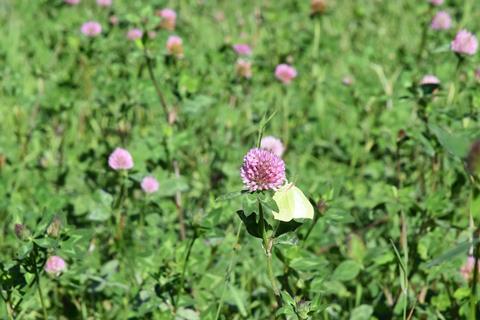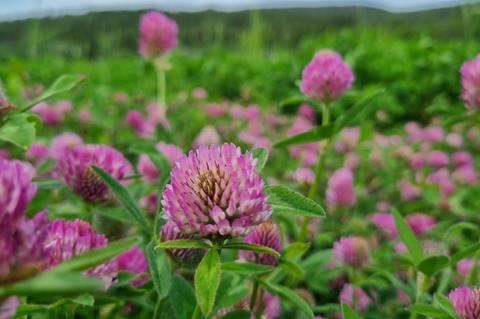Losses in red clover plant numbers within forage mixtures in the years after they are sown are not only connected to fungal pathogens in the soil, but also how far south they are grown, with implications for how climate change could affect livestock farms, a new study has found.
The study by a team at the Swedish University of Agricultural Sciences is outlined in the paper ‘Red clover root-associated microbiota is shaped by geographic location and choice of farming system’, which has been accepted by the Journal of Applied Microbiology, an Applied Microbiology International publication.
Key crop
Red clover (Trifolium pratense) is most important forage legume crop in temperate agriculture and is a vital component of sustainable intensification of livestock farming systems because of its high-quality fodder crop. In Sweden it is most commonly grown intercropped with forage grass species and sometimes mixed with other forage legumes.

Corresponding author Professor Christina Dixelius said that of the land used for agricultural activities in Sweden, 15% is used for pasture - of the remaining share 42% is devoted to leys and the rest is arable land for crop production, so red clover is by far the dominant legume crop in Sweden.
“Red clover offers high-value feed to livestock, due to its high digestibility, high voluntary intake by livestock and high protein content during ensiling. It is also associated with many advantages and ecosystem services, including nitrogen fixation, improved soil structure, and promotion of genetic diversity through insect pollination,” she said.
Year-on-year losses
“The problem with red clover is when we see reduced persistence, ie. when the number of red clover plants in a forage mixture are drastically reduced each year, resulting in the loss of all these advantages.
“This reduced persistence could be due to soil-borne pathogens. Fusarium spp. causing root rot and Sclerotinia trifoliorum, causing clover rot, are well-known red clover pathogens.
“We were interested to see whether there are any other pathogens present in soil that cause low persistence and also interested to see what other microbes are present. We also want to see how geographic locations in Sweden that have different climatic conditions and choice of farming system will influence the microbial diversity. It’s also of importance to know which pathogens, if any, to breed against.”
Sampling farms
The study examined three geographical regions in Sweden - north, central and south - and evaluated the red clover root associated microbiota to clarify the presence of pathogenic and beneficial microorganisms in 89 Swedish field sites, including conventional and organic farms.

DNA was extracted from all 214 samples collected, followed by community microbial profiling by Illumina and PacBio amplicon sequencing.
Samples from the southern region were found to be less diverse than those from the northern and central regions, and samples from organic farms were more diverse than those from conventional farms. However, more potential pathogens were found in the south.
Bacterial taxa within root-associated microbiota communities were more abundant, as expected, followed by fungal, archaea and protist taxa.
The abundance of R. leguminosarum bv. trifolii showed a decreasing trend from north to south but no major influence of farming systems was observed.
Pathogenic fungi patterns
A total of 62 potential pathogenic fungi were identified, with a bias toward grass pathogens and a higher abundance in samples from conventional farms and southern region of Sweden. A gradient of increasing abundance from north to south was found for Neonectria sp., Dactylonectria hordeicola, Didymella macrostoma, and Plectosphaerella pauciseptata. These taxa were also more prevalent in samples from conventional farms. No fungal pathogens were enriched in the samples from organic farms.
A higher number of saprotrophic or endophytic fungi and a lower number of pathogenic fungi were enriched in the northern region than in the central and southern regions.
Co-occurrence patterns
To gain further insights into the co-occurrence patterns of red clover root-associated communities in different regions and farming systems, intrakingdom and interkingdom networks were constructed using the top 50 most abundant taxa to facilitate the visual interpretation of the interactions. Rhizobium leguminosarum bv. trifolii is a keystone species in the northern region and in organic farms.
Co-occurrence networks revealed that the R. leguminosarum bv. trifolii was negatively associated with all fungal pathogenic species taxa recognized in this study.

“These results highlight two components that greatly impact the population shift between pathogenic and beneficial groups of microbes - geographic location (north) and organic farming are clearly associated with beneficial microbial communities,” Professor Dixelius said.
“Abundance of fungal species based on amplicon sequencing is not correlated with pathogenicity levels. This information tells us that microbiome data must be followed up by biological testing to draw correct conclusions on potential damage by pathogens.
“Fusarium avenaceum and Sclerotinia trifoliorum are well-known red clover pathogens. These two pathogens caused high disease index, particularly F. avenaceum.”
Climate change pressure
Commenting on the findings, Professor Dixelius said climate change has become a reality in Sweden and other countries on the same latitude, particularly when it comes to food and feed production.
“One problem is the increasing pressure of plant pathogens, and the daylength is fixed, restricting the choice of crops.Besides the biodiversity and pathogenic information, our data can be used in measurements of future changes of biodiversity due to changed climate,” she said.
“Regarding new red clover pathogens, especially fungi using grass as hosts identified in the study, these could potentially form a reservoir in the soil as pathogens posing threats to cereals. Enrichment of fungal species with mycotoxin properties is of particular concern requiring follow-up monitoring.
Soil-borne pathogens
“Soil-borne pathogens are problematic in general. Not only are they ‘invisible’, but soil is a complex matrix to work with in terms of inoculation. No treatments are available - old ones, if they exist, are banned due to their toxicity. And soil-borne pathogens have a tendency to survive for years in soil and debris.
“Resistance breeding is the first choice to improve the situation but is a challenging strategy. Therefore, working with the ‘correct’ pathogens is important.”
Next steps, Professor Dixelius says, include carefully monitoring incidence and increase of grass and small-grain cereal pathogens such as Gibberella tricincta (Fusarium tricinctum), F. culmorum, and D. hordeicola, all which could pose threats to several crops and animals.
“The latter is due to possible production of toxic substances by the fungi. Climate change could be a factor that poses extra stress on those fungi, and could trigger potential toxin development and/or possible DNA exchange between the fungal species. That explains the complexity of Fusarum taxonomy.”
New investigations
Rhizobium leguminosarum bv. trifolii protects the clover roots from pathogens to some extent and it would be great to understand this finding and exploit it if possible, she said.
“The results generated in this study form the basis for a range of new investigations to understand the impact on microbe populations by contrasting climate conditions, farms with different cultivation regimes and crop rotation schemes, potential fungal pathogens and nutrient status in the soils,” Professor Dixelius said.
Carbon sequestering potential
“Red clover can promote high carbon sequestering in arable soil and harbours various beneficial microbes for plant growth and ecosystem sustainability. Increased use of red clover is one of several suggested measures to mitigate the negative impact of climate change.
“This is of particular importance in Sweden where the annual projected temperature rise is higher than the global mean (www.ipcc.ch). An estimated increase of up to 0.5 °C per 10 years leads to rapid changes in climate zones and new constraints for food and feed production, including increasing challenges from pathogens.”
People and support
Professor Dixelius conceived the study and performed part of the field sampling. Shridhar Jambagi carried out all laboratory work and designed and performed most parts of the bioinformatic analysis. Kristian Persson Hodén edited the R scripts used for data analysis. Linda Öhlund identified most field sites, and performed a large part of the sampling. Christina Dixelius and Shridhar Jambagi interpreted the data and wrote the manuscript. All authors read and approved the final version of the manuscript.
This work was supported by a grant from the Swedish University of Agricultural Sciences, Grogrund Initiative. Sequencing was performed by the SNP&SEQ Technology Platform in Uppsala. The facility is part of the National Genomics Infrastructure (NGI) Sweden and Science for Life Laboratory. The SNP&SEQ Platform is also supported by the Swedish Research Council and the Knut and Alice Wallenberg Foundation. Work performed at NGI/Uppsala Genome Center has been funded by RFI/VR and Science for Life Laboratory, Sweden.
‘Red clover root-associated microbiota is shaped by geographic location and choice of farming system’ appears in the Journal of Applied Microbiology.
Topics
- Agriculture
- Applied Microbiology International
- carbon sequestering
- Christina Dixelius
- Climate Action
- Community
- Dactylonectria hordeicola
- Didymella macrostoma
- forage
- Fungal Therapeutics
- Fungi
- Fusarium
- Fusarium avenaceum
- Gibberella tricincta
- Healthy Land
- Illumina
- Kristian Persson Hodén
- legume
- Linda Öhlund
- Neonectria
- PacBio
- Plectosphaerella pauciseptata
- red clover
- Research News
- Rhizobium leguminosarum bv. trifolii
- Sclerotinia trifoliorum
- Shridhar Jambagi
- Soil & Plant Science
- soil pathogens
- Swedish University of Agricultural Sciences
- Trifolium pratense
- UK & Rest of Europe







No comments yet